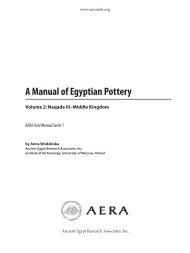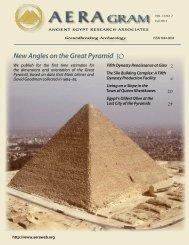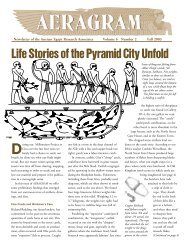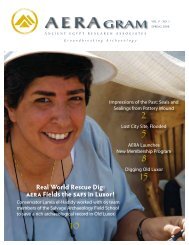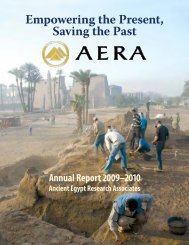The Khentkawes Town (KKT) - Ancient Egypt Research Associates
The Khentkawes Town (KKT) - Ancient Egypt Research Associates
The Khentkawes Town (KKT) - Ancient Egypt Research Associates
Create successful ePaper yourself
Turn your PDF publications into a flip-book with our unique Google optimized e-Paper software.
www.aeraweb.org<br />
posite: the two cases of osteoarthritic changes to the lower<br />
spine occurred in the female individuals, while the male in<br />
Burial 457 had osteoarthritic changes to the cervical spine<br />
(Atlas and Axis).<br />
In addition to the vertebral lipping, the older woman<br />
in Burial 457 also suffered from joint changes in her left<br />
hand, as well as healed Cribra Orbitalia and active Porotic<br />
Hyperostosis of the Parietals and Occipital bones (porosity<br />
of the orbital roofs and cranial bones, respectively). <strong>The</strong>se<br />
two lesions are quite common in archaeological materials,<br />
and are usually attributed to iron deficiency anemia<br />
(Aufderheide and Rodriguez-Martin 1998: 348–350). <strong>The</strong><br />
exact cause of the anemia is impossible to determine, but<br />
in women it is often thought to be connected to breast feeding<br />
or nutritional deficiencies. Because of the advanced age<br />
of the female in Burial 457, it is probably safe to assume<br />
that the latter is more likely to be the cause of her cranial<br />
lesions.<br />
Dental Health<br />
<strong>The</strong> dentition is the only feature of the human skeleton<br />
that directly interacts with the environment during life,<br />
providing archaeologists with information on health,<br />
stress and disease, diet, occupation, economy, and cultural<br />
behavior. Further, teeth are the hardest and the most<br />
indestructible of human tissues, and often outlast other<br />
skeletal elements in the archaeological record. Because<br />
of the post-depositional disturbance in <strong>KKT</strong>, however,<br />
teeth were only recovered from four individuals, Burial<br />
454 and 455, and from the two individuals in Burial 457.<br />
In all four cases, the teeth recovered showed evidence of<br />
extensive dental attrition. Dental attrition is one of several<br />
degenerative changes associated with aging (Aufderheide<br />
and Rodriguez-Martin 1998: 398). Because of the excessive<br />
amount of grit in the foodstuffs of ancient <strong>Egypt</strong>ians,<br />
dental attrition is often particularly pronounced in skeletal<br />
assemblages from <strong>Egypt</strong> (Leek 1972). <strong>The</strong> dental wear in<br />
the four cases from <strong>KKT</strong> ranged from 5+-7, according to<br />
the Brothwell scoring system, indicating an advanced age<br />
for all four individuals, even with the often greater wear in<br />
<strong>Ancient</strong> <strong>Egypt</strong>ians taken into account. In one case, the male<br />
in Burial 457, the attrition was so severe that it had caused<br />
osteoarthritic changes and eburnation to the temporomandibular<br />
joint (Hodges 1991). This individual also had<br />
a large interproximal cavity between the right mandibular<br />
second and third molars, with slight abscess formation<br />
at the apex of the tooth roots. In addition, this individual<br />
displayed extensive and highly uneven wear of all four<br />
upper incisors, as well as the left maxillary premolars,<br />
indicating that he may have used his teeth as tools during<br />
life. Both individuals in Burial 457 also showed signs of<br />
periodontal disease, with several teeth lost antemortem. In<br />
Burials 454 and 455, not enough remained of the alveolar<br />
bone to determine whether or not the individuals suffered<br />
from periodontal disease.<br />
Finds<br />
<strong>The</strong> preservation of the nine burials excavated in 2008 was<br />
poor; what was present was generally fragmentary or bone<br />
stains. Previous excavation by Selim Hassan or other postburial<br />
cuts damaged the majority with only three burials<br />
more complete (Burials 453, 454, and 457) but fragmented/<br />
eroded by the burial environment. Beads were found in five<br />
burials (Burials 454, 455, 457, 458, and 459). Pottery sherds<br />
consistent with the 6 th Dynasty or earlier, and charcoal<br />
material was found in the fill of the majority of the burials<br />
and this material was separated for further analysis. No<br />
apparent masks were found with these burials and the<br />
skeletal remains were fragmentary and/or incomplete.<br />
Dating<br />
All the burials excavated at <strong>KKT</strong> had been truncated to<br />
some extent, presumably by the Selim Hassan excavations,<br />
and none were preserved to their original depth. Thus,<br />
the original surface from which the burials were cut is<br />
lost to us. This, coupled with the fact that there were no<br />
intentional burial items in the graves that were strong<br />
chronological indicators, makes dating the remains very<br />
difficult. Pottery sherds and a small number of beads and<br />
fragments of mother-of-pearl were found in the burial<br />
fills, but not in immediate association with the bodies.<br />
Thus, these items could have been deposited accidentally<br />
in the burial fills during the infilling of the cuts at the time<br />
of burial. Two of the deeper burials contained a layer of<br />
limestone, similar to the Late Period burials south of the<br />
Wall of the Crow East at the HeG site. However, none of<br />
the pottery that came out of the burial fills was later than<br />
the 6 th Dynasty (A. Wodzińska, personal communication,<br />
2008). Of course, this may be due to abandonment of the<br />
area after the 6 th Dynasty, and does not in itself mean that<br />
the burials date to this period, since none of the pottery<br />
sherds came from complete jars. In addition, there was no<br />
indication of the bodies having been tightly wrapped, as<br />
would be expected if they dated from the Late, Ptolemaic,<br />
or Roman Periods (the position of the skeletal elements in<br />
the burials at the HeG site often shows evidence of tight<br />
wrapping). Further, the north-south orientation of the<br />
burials is inconsistent with a Late Period or later date, as<br />
burials from these periods are usually oriented east-west. In<br />
lower status Old Kingdom burials, the bodies are typically<br />
in a tightly flexed position, though oriented north-south.<br />
<strong>The</strong> lack of grave goods and grave markers suggests that<br />
the <strong>KKT</strong> burials were not of high status, so the extended<br />
burial position is probably also inconsistent with an Old<br />
Kingdom date. <strong>The</strong>re is ample evidence for a north-south<br />
extended position in Old Kingdom burials, but then it is<br />
52<br />
Giza Plateau Mapping Project Season 2008 Preliminary Report





